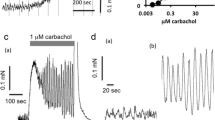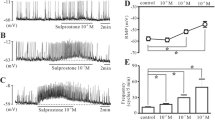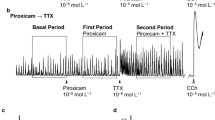Abstract
Substance P (SP) is a neurotransmitter peptide that is widely distributed in the body. Since SP has been demonstra in the gallbladder (GB) and bile ducts of dogs, it may have a role in biliary motility. The objective of this study was to examine the effect of SP on the GB and sphincter of Oddi (SOD) of dogs in vitro,to evaluate the structure-activity relationship of SP, and to compare the contractile effect of SP with that of cholecystokinin octapeptide (CCK-8) and acetylcholine (Ach). Isolated longitudinal strips of GB and SOD from dogs were suspended in oxygenated Krebs buffer and the isometric tension responses to various doses of CCK-8, Ach, SP, and SP homologs [SP-free acid (SPFA), Octa-SP (O-SP), physalaemin (PHY)] were measured. We found that all the SP homologs, other than SPFA, stimulated GB and SOD contractions in vitroin a dose-dependent manner. The potency of SP and its homologs on GB and SOD was SP ≥PHY > O-SP; SPFA was without effect. CCK-8 was significantly more effective than SP on GB contraction, but unlike SP, CCK had no effect on SOD. The maximum contraction achieved by Ach was 1.3 (SOD) to 2.3 (GB) times greater than that achieved by SP, but the ED 50 of SP was approximately 100- to 200-fold lower than that of Ach. The contractile effect of SP was partially blocked by 10 −5 M atropine. We suggest from the above results that contractile effects of SP on the dog GB and SOD are probably mediated through binding to specific SP receptors that require the C-terminal amino group and the C-terminal penta-peptide sequence in order to be most effective.
Similar content being viewed by others
References
von Euler US, Gaddum JH: An unidentified depressor substance in certain tissue extracts. J Physiol 72;74–87, 1931
Holzer P, Bucsics A, Saria A, Lembeck F: A study of the concentrations of substance P and neurotensin in the gastrointestinal tract of various mammals. Neuroscience 7:2919–2924, 1982
Pernow B: Substance P. Pharmacol. Rev 35:85–140, 1983
Bartho L, Holzer P: Search for a physiological role of substance P in gastrointestinal motility. Neuroscience 16:1–32, 1985
Brodin E, Nilsson G: Concentration of substance P-like immunoreactivity (SPLI) in tissues of dog, rat and mouse. Acta Physiol Scand 112:305–312, 1981
Heitz P, Polak JM, Kasper M, Timson CM, Pearse AGE: Immunoelectron cytochemical localization of motilin and substance P in rabbit bile duct enterochromaffin (EC) cells. Histochemistry 50:319–325, 1977
Cai W, Gu J, Huang W, McGregor GP, Ghatei MA: Peptide immunoreactive nerves and cells of guinea pig gallbladder and biliary pathways. Gut 24:1186–1193, 1983
Bjurstedt H, von Euler US, Gernandt B: Biological actions of substance P and its relation to cholecystokinin. Skand Arch Physiol 832:257–265, 1940
Hultman EH: The relation between cholecystokinin and substance P. Acta Chem Scand 6:1042, 1955
Lembeck F, Juan H: Comparative action of peptides on the gallbladder and the sphincter of Oddi. Adv Exp Med Biol 21:337–346, 1972
Pernow B: Studies on substance P. Purification, occurrence and biological actions. Acta Physiol Scand 29:7–31, 1953
Starke K, Lembeck F, Lorenz W, Weiss U: Gallen- und pankreas-sekretion unter substance P und einem physalamin-derivat. Naunyn-Schmiedebergs Arch Parmak Exp Pathol 260:269–274, 1986
Mate LJ, Sakamoto T, Thompson JC: The effect of substance P on gallbladder motilityin vivo andin vitro. Proc Soc Exp Biol Med 175:257, 1984
Berry H, Flower RJ: The assay of endogenous cholecystokinin and factors influencing its release in the dog and cat. Gastroenterology 60:409–420, 1971
Guo Y-S, Singh P, Upp JR Jr, Thompson JC: Speciesspecific effects of neurotensin on gallbladder contractionin vitro. Dig Dis Sci 34:21–26, 1989
Toouli J, Watts JM:In-vitro motility studies on the dog and human extrahepatic biliary tracts. Aust NZ J Surg 40:380–387, 1971
Toouli J, Watts JM: Actions of cholecystokinin/pancreozymin, secretin and gastrin on extra-hepatic biliary tract motilityin vitro. Ann Surg 175:439–447, 1972
Severi C, Glider JR, Makhlouf: Identification of separate bombesin and substance P receptors on isolated muscle cells from canine gallbladder. J Pharmacol Exp Ther 245:195–198, 1988
Watson SP: Are the proposed substance P receptor subtypes, substance P receptors? Life Sci 25:797–808, 1984
Regoli D, Mizarahi J, D'Orleans-Juste P, Dion S, Drapeau G, Escher E: Substance P antagonists showing some selectivity for different receptor types. Eur J Pharmacol 109:121–125, 1985
Regoli D, Miarahi J, D'Orleans-Juste P, Escher E: Receptors for substance P. II. Classification by agonist fragments and homologues. Eur J Pharmacol 97:171–177, 1984
Persson CGA: Adrenoceptor functions in the cat choledochoduodenal junctionin vitro. Br J Pharmacol 42:447–461, 1971
Ryan JP: Motility of the gallbladder and biliary tree.In Physiology of Gastrointestinal Tract. LR Johnson (ed). New York, Raven Press, 1981, pp 473–494
Lin T-M: Actions of gastrointestinal hormones and related peptides on the motor function of the biliary tract. Gastroenterology 69:1006–1022, 1975
Persson CGA: Dual effects on the sphincter of Oddi and gallbladder induced by stimulation of the right great splanchnic nerve. Acta Physiol Scand 87:334–343, 1973
Bauer AJ, Schmalz PF, Szurszewski JH: Effect of CCK-OP on mechanical and intracellular electrical activities of the choledochoduodenal junction of various mammals. Gastroenterology 90:1340, 1986
Nakata K, Kurashi K: Effects of C-terminal octapeptide of cholecystokinin and prostaglandins on adrenergic functions in the guinea-pig gallbladder and sphincter of Oddi. Jpn J Pharmacol 31:77–83, 1981
Singh P, Singh H, Laridjani A, Lluis F, Gomez G, Townsend CM Jr, Thompson JC: Binding kinetics of cholecystokininreceptors on gallbladder and pancreas are similar in humans, rabbits and dogs. Gastroenterology 90:1636, 1986
Wiley J, O'Dorisio T, Owyang C: Cholecystokinin-induced relaxation of sphincter of Oddi is mediated by vasoactive intestinal polypeptide. Gastroenterology 90:1692, 1986
Watts JMcK, Dunphy JE: The role of the common bile duct in biliary dynamics. Surg Gynecol Obstet 122:1207–1218, 1966
Author information
Authors and Affiliations
Additional information
Supported by grants from the National Institute of Health (RO1 AM 15241, PO1 DK 35608, and CA 38651).
Rights and permissions
About this article
Cite this article
Guo, Y.S., Singh, P., Gomez, G. et al. Contractile response of canine gallbladder and sphincter of Oddi to substance P and related peptidesin vitro . Digest Dis Sci 34, 812–817 (1989). https://doi.org/10.1007/BF01540263
Received:
Revised:
Accepted:
Issue Date:
DOI: https://doi.org/10.1007/BF01540263




